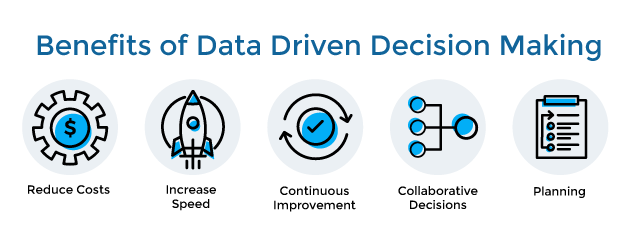Remember what we discussed last week? We emphasized the core value of “human” in smart manufacturing. Being the core value in smart manufacturing, we, humans, are not replacing but supercharging ourselves with technology. However, there are way too many digital transformation tools to choose from. We don’t know how to decide on the right one, afraid that we may throw good money for bad. So, how do we “master technology,” and let the data assist future decisions?
The journey of DDDM
DDDM, full name as, “Data-Driven Decision Making.” This might be a brand-new idea for most of us. Collecting data is already a big mountain to climb, and now we are further hoping this could drive the company’s operations? Sounds like an unreachable goal.
But don’t give up yet! In fact, we can make this happen by planning this as a simple, one-way thought, including five different processes.
Analyze our need for technology/ digital tools: Know the key and go straight to the point
For example, if we only have a small-scale of IE team, it is impossible for us to manage the production line perfectly. What we can know is that we need help from technology, such as AI vision, to alleviate the workload of engineers and allow the limited manpower on the shop floor to do decision-driven duties.
Know the “how.” Effectively collect data
Is your IE team still doing paperwork? Or are you still creating line balance graphics by keying in each segment? Choosing the right transformation tool can save you a considerable amount of time and manpower when it comes to the collection of an accurate, large amount of data.
Analysis and induction: extracting available value
Please don’t let this useful data drown in your data lake! Wasting time and resources by storing huge amounts of data without making any good use.
Visualization: Do not turn a blind eye to improvement you need to make
With visible data, we can visualize improvement. Numbers are more intuitive than words and can present an overview.
Standardization: Development Regulations & Visualized Future Blueprint
After knowing the root problems and bottlenecks, we can make plans for our goal and know the aspects of improvement.
What kind of decisions are actually been driven?
FYI
VUCA is an acronym for Volatility, Uncertainty, Complexity, and Ambiguity. Under the huge changes in the supply chain, “volatility” is continuous, and “uncertainty” will also be the norm. The frequency and destructiveness of the two will far exceed the past, and the challenges faced by enterprises are unprecedented. Only by deploying in advance can we have full confidence. Use the right tools to collect data, coupled with the intuitive neutrality of technology, integrate and connect different information. Data will show dynamic changes, which we called called “data movement.”
“Only with data figures, can we see the room for improvement, and only after we improved, can we make dynamic adjustments in the future.”
— read more in <Data Ownership: Smart Manufacturing on Full Data Support>
Using the right tools to collect data, coupled with the intuitive neutrality of technology, integrate and connect different information. AI vision can provide the following benefits, fully presenting data trends, assisting enterprises in developing regulations and formulating future plans.
No defect Defective items that are returned, are a waste of materials and an expense of cost. AI vision can keep the quality of items in check, eliminate errors that are not detected by humans, find problems, and reduce the chance of reworking defective items.
Visualized the production line through images, get analyzed reports, eliminate bottlenecks, and smooth the production.
Clearly presents blind spot, so that everyone understands the difficulties they are encountering transparently.
Real-time vision. With this, Taiwan HQ can be updated from a foreign factory with zero time difference. Digital twins can also be used to simulate the production line before the actual factory is built.
Planning future roadmap with the data collected by AI, allowing factories to quickly clarify the direction of future efforts.
Having the movement of these data is like knowing the whole story of the production line. From the very first moment of recording, there is accurate and precise information, which is convenient to measure the performance of the factory at any stage at any time.

Benefits of data driven decision making
Driven by data: Building mutual language between departments
“For businesses that want to really make progress, data-driven diversity and inclusion is the way to the future.”
—Wayne Curry, Bloomberg, China.
Let’s summarized this up. We can say that with these operations, compaines are able to figure out the direction of improvement. Starting with the data collection and digital system to make progress. From data collection, we can know what we are currently lacking and see the need for change. Using the system, data can be shared between departments, establishing a mutual communication platform. Different departments can avoid being cynical, thereby achieving the goal of optimization.
PowerArena HOP: Your best assistant for data collection
Complete and accurate data will be your best material to successfully transform in the time of industry 4.0.
PowerArena’s Human Operation Platform (HOP) is fully supported by AI vision, capturing operators’ movements from every production line. Recording data 24/7, visualizing the production line, meanwhile, analyzing the root problems and bottlenecks to provide the most accurate production line information. Empower operations with data-driven decisions, putting the power of data back in your hands.
Next week, we will put our focus back to factory workers, sharing our thought on their “working value”. See you next week!





